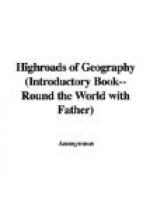9. Then father told us many things about his travels. “I have been right round the world,” he said. “I sailed to the East, and I went on and on until I returned to the place from which I set out.”
[Illustration: {Father at home with his family}]
“I know,” cried Tom. “I have followed you all round the world on the globe.”
10. May was sitting on father’s knee. “Dad,” she said, “I suppose you are the very first man who has ever been right round the world.” “Of course he is,” said Tom.
11. Father laughed. “No, my dear,” he replied; “thousands of men had been round the world before I was born.”
12. “I’m so sorry,” said May. “I did so want to tell the girls at school that my father was the very first man who ever went round the world.”
EXERCISES.
(To be worked under the direction of the teacher)
* * * * *
Lesson 1.
1. The father travelled by train. In what other ways might he have travelled? Which is the fastest way? Which is the slowest?
2. What power drives the train? What other work does this power do?
3. Look carefully at the first picture in this book. Describe it.
4. Learn: A globe is a small model of the earth. Of what shape is the earth? Of what shape are the sun, moon, and stars?
Lesson 2.
1. The name of the town on the seashore (par. 2) is Dover. Turn to the picture on page 11 {Illustration entitled “The White Cliffs of Dover”} and describe the cliffs of Dover as seen from the sea.
2. The distance between Dover and Calais is only twenty-one miles. Learn: A narrow passage of water joining two seas is called a strait. The word strait means “narrow.” This strait is called the Strait of Dover.
3. Model the Strait of Dover in clay or plasticine. Suppose the water between England and France were to dry up, what would the strait be then? Write out and learn: A valley is a hollow between hills or mountains.
Lesson 3.
1. The river which runs through Paris is called the Seine. The river which runs through London is called the Thames. Learn: A river is a large stream of fresh water flowing across the land to join another river, a lake, or the sea.
2. Look carefully at the picture on page 14 {Illustration entitled “In the Gardens”} and describe it.
3. Compare French boys with English boys. Compare French girls with English girls.
Lesson 4.
1. Look carefully at the picture on page 18 {Illustration entitled “The Grape Harvest”} and describe it.
[Illustration: {Silkworm on mulberry leaf}]
2. Copy this little drawing of the silkworm and the mulberry leaf.
3. Why do flowers bloom earlier in the south of France than in England?




